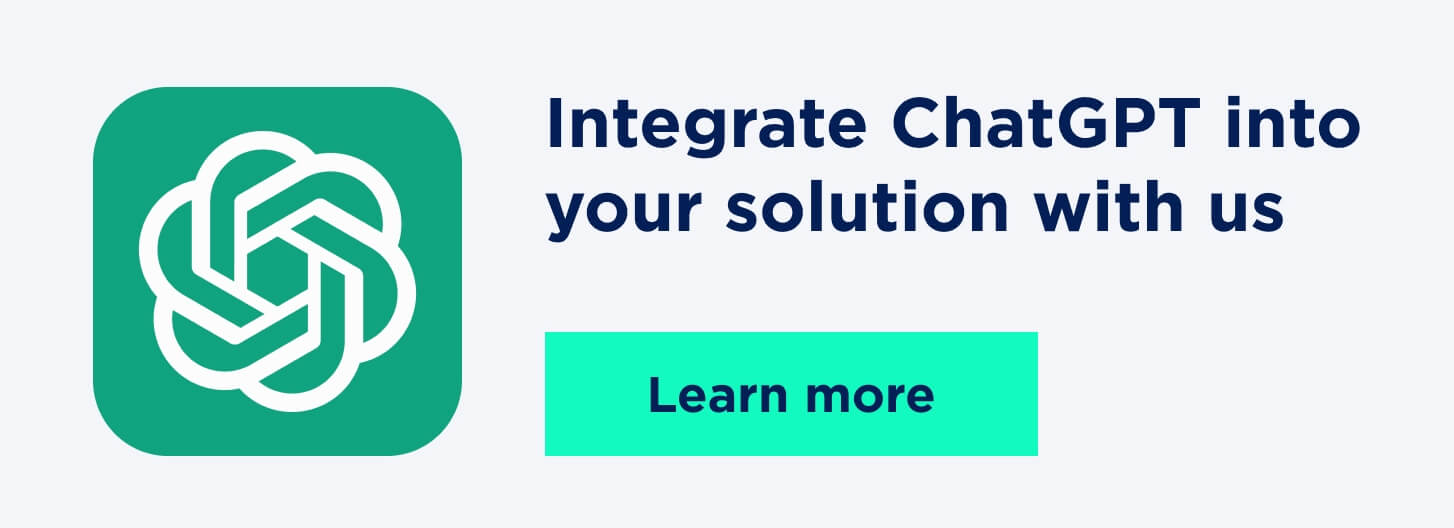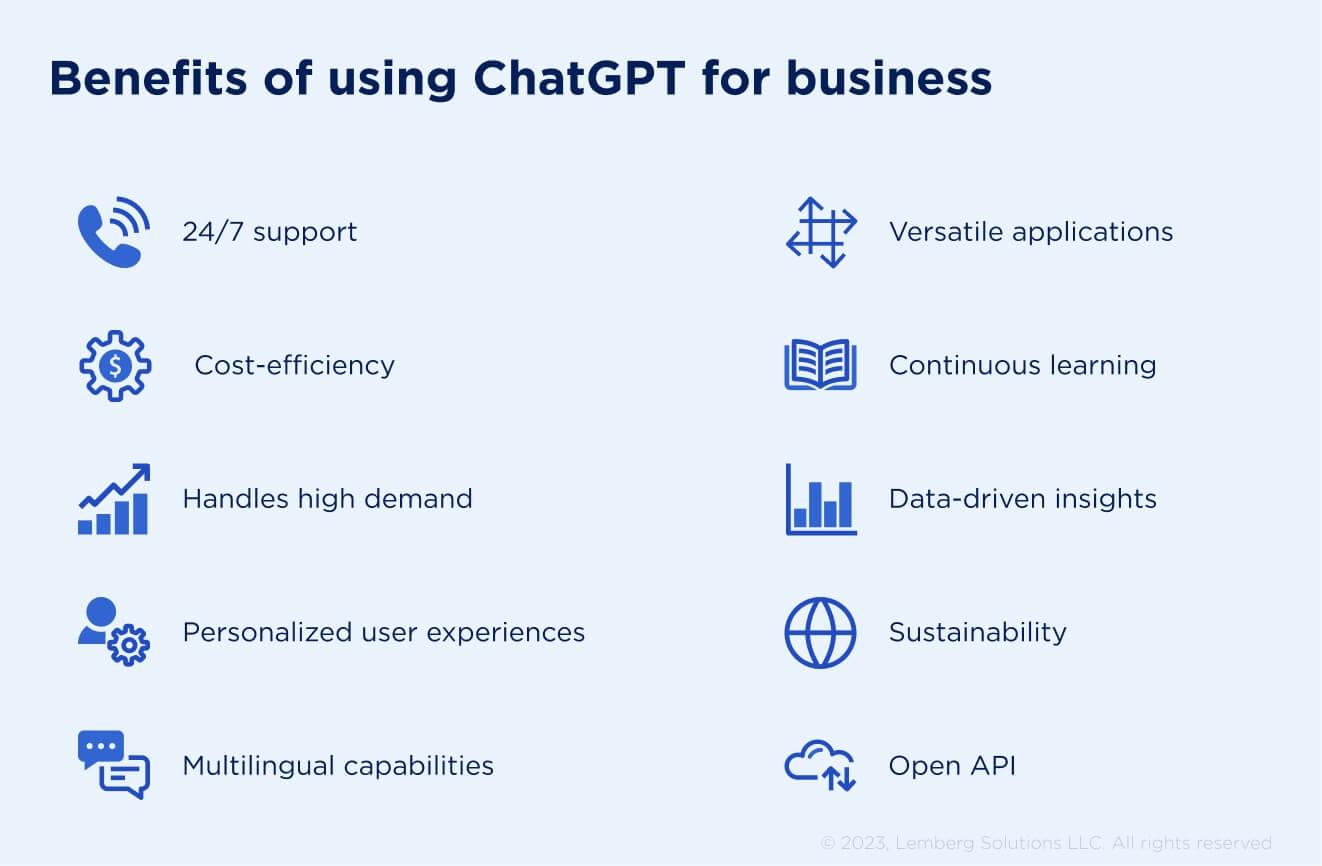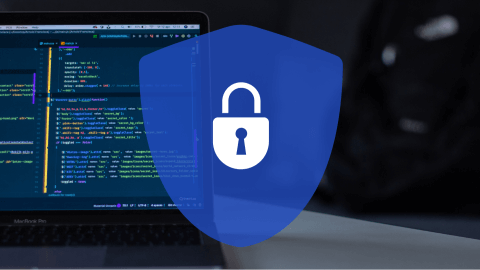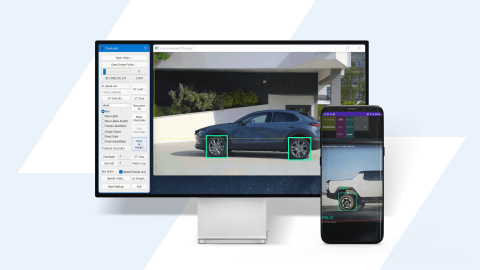When ChatGPT was first introduced to the market, it quickly became a concern for numerous businesses. Resistance is a common reaction to innovative solutions since they require more effort to stay afloat and even beat the competition. However, flexibility and adaptability to modern trends are crucial for maintaining a competitive edge.
Mastering the art of using ChatGPT for the benefit of your business is a must. This article aims to clarify the benefits of ChatGPT and its difference from GPT-3 and GPT-4, share tips on how to use ChatGPT for business, and describe real-life applications that you can leverage for your business.

What is ChatGPT?
ChatGPT is an AI chatbot that generates responses to users’ unique requests. ChatGPT was developed by OpenAI and quickly became a global sensation. Chatbots apply ML models to communicate with people and simulate human-to-human conversation. OpenAI trained ChatGPT on large textual datasets based on the information from the Internet up until 2021. Training data taken from web resources enables ChatGPT to provide immediate responses on different topics.
Difference between ChatGPT, GPT-3, and GPT-4
OpenAI has significantly contributed to the evolution of natural language processing, with its GPT models setting benchmarks in the industry. However, understanding the distinction between ChatGPT, GPT-3, and GPT-4 is crucial to make the most of their unique offerings.
ChatGPT
ChatGPT is a web-based application accessible via browsers for conversational interactions. This AI chatbot leverages GPT's language model to engage with humans, replicating nuanced conversational patterns. OpenAI's content filters also ensure that the dialogues remain coherent and relevant. The app serves as a user-friendly interface for convenient communication between humans and AI. ChatGPT is an AI chatbot that operates using GPT-3 and GPT-4.
GPT-3 and GPT-4
GPT-3 and GPT-4 are the multimodal models created by OpenAI and trained to recognize text inputs, analyze them, and provide text outputs. GPT, Generative Pre-trained Transformer, is the intellectual engine — the language model itself. GPT isn't only about chatting with end users. This model encompasses text summarizing, copywriting, coding, and translating. Through OpenAI's API, developers can integrate the potential of GPT-3 or GPT-4 into different AI applications.
With 175 billion parameters, GPT-3 marked a significant leap in the field of natural language models. However, GPT-4, released on March 14, 2023, pushed this boundary by presenting almost trillion parameters. This increase implies GPT-4's boosted accuracy and operation speed.
The difference in data input is considerable. GPT-3 utilizes 17 gigabytes of data, whereas GPT-4's training has involved 45 gigabytes. The increase in training data makes GPT-4 far more precise than its predecessor.
GPT-3's capabilities range from generating human-like text and code to crafting detailed articles, stories, and apt social media texts. GPT-4, with its expanded parameters, is expected to understand the context of human language better, diving into complex tasks and grasping linguistic intricacies like idioms.
GPT-4 is not a limit for OpenAI's relentless pursuit of enhancing ChatGPT's capabilities. The chatbot promises to maintain the top position in the long run and present more sensational updates in the future.

The benefits of using ChatGPT for business
In a fast-paced digital ecosystem, businesses constantly seek innovative tools to stay ahead of the competition, and ChatGPT is a powerful helper. Integrating ChatGPT into business operations unleashes numerous advantages and enables companies to optimize their processes, improve customer interactions, and use data more efficiently.
Find some of the benefits of adopting ChatGPT for business below:
Enhanced customer support
ChatGPT can be deployed as a 24/7 virtual assistant, addressing customer requests in real time. This ensures swift resolutions and a consistent level of service, reducing the probability of human error and enhancing customer satisfaction.
Cost-efficiency
Businesses can significantly cut operational costs by automating routine queries and tasks with ChatGPT. It minimizes the need for a large customer support team and enables business owners to pay more attention to complex and high-priority tasks.
Scalable interactions
During peak periods or promotional campaigns, businesses often experience an increase in customer interactions. ChatGPT can handle multiple queries simultaneously, ensuring no customer is left waiting.
Personalized user experiences
ChatGPT can be trained to analyze user data and provide personalized responses. This tailored approach can increase user engagement, potentially boosting sales and brand loyalty.
Multilingual capabilities
For businesses operating in diverse regions, language barriers can be challenging. ChatGPT, with its expansive language model, can communicate in multiple languages, breaking down these barriers and ensuring a wider customer reach.
Versatile applications
Beyond customer support, ChatGPT can assist in internal operations. Whether it's drafting emails, generating reports, or assisting in data analysis, ChatGPT's adaptability can enhance productivity across departments.
Continuous learning
The more ChatGPT interacts, the more it learns. This continuous feedback loop ensures that the system constantly evolves, refining its responses and adapting to the ever-changing business environment.
Data-driven insights
Every interaction with ChatGPT is a data point. Analyzing these interactions can offer valuable insights into customer behavior, preferences, and pain points, aiding in better business decision-making.
Seamless integration
With its open API, ChatGPT can be effortlessly integrated into existing business systems, be it CRM platforms, websites, or mobile applications, ensuring a unified user experience.
Sustainable operations
In an age of sustainability, using ChatGPT reduces the need for extensive physical infrastructure and resources, which aligns with green business practices.
In essence, ChatGPT is a strategic business tool. By integrating ChatGPT into business operations, businesses can leverage a ready-made AI solution to streamline processes, offer unparalleled customer experiences, and derive insights that drive growth. In an ever-evolving business landscape, tools like ChatGPT ensure agility, efficiency, and sustained success.

12 tips for using ChatGPT for business
To extract ChatGPT’s full potential, a strategic approach is essential. Here are some tips to help businesses optimize their experience with ChatGPT:
1. Define clear objectives
Before deploying ChatGPT, outline your expectations. Whether it's automating customer support, receiving data analysis assistance, or generating content — having clear objectives ensures effective ChatGPT application.
2. Train and fine-tune
ChatGPT's default model is robust, but businesses can benefit from fine-tuning it with domain-specific data. This ensures the bot understands your industry, specific products and services, and aligns with the brand's tone and style.
3. Design a user-friendly interface
Ensure that the platform where ChatGPT is deployed is user-friendly. A seamless user experience can significantly enhance engagement and satisfaction.
4. Establish boundaries
While ChatGPT is versatile, it's essential to communicate the limits of its functionalities. Make sure users understand what the chatbot can and cannot do to manage expectations properly.
5. Adopt continuous monitoring
Regularly review the interactions that ChatGPT handles. This will help you identify areas of improvement, address recurring issues, and update the bot's knowledge base.
6. Personalize the experience
Leverage ChatGPT's ability to analyze and respond based on user data. Personalized greetings or product recommendations can lead to higher conversion rates.
7. Maintain a human backup
For complex queries or sensitive issues, always have a mechanism for users to transition from ChatGPT to a human representative. This ensures comprehensive support.
8. Update regularly
Business offerings, policies, or environments may change. Regularly update ChatGPT's knowledge base to reflect these changes, ensuring accurate and up-to-date information dissemination.
9. Encourage feedback
Allow users to provide feedback on their interactions with ChatGPT. This will not only help in refining its responses but also provide insights into user needs and expectations.
10. Stay updated
As OpenAI continues to innovate and refine its models, businesses should keep up with updates or new features that could improve their ChatGPT experience.
11. Ensure data security
If ChatGPT handles sensitive business data or customer information, enable proper encryption and data protection measures to uphold privacy and trust.
12. Promote the bot
Inform your customers about the chatbot's availability. A brief introduction or tutorial can help users understand the best ways to utilize ChatGPT for their needs.
By integrating these strategies, organizations can ensure they're not just keeping up with the trends but are optimizing their businesses by adopting ChatGPT. In a world where AI is revolutionizing industries, strategy will help you lead the market. With these tips, ChatGPT will contribute to the transformative growth of your business.

ChatGPT business applications
If you have ever wondered how to use ChatGPT for your business, check out the following ideas and choose the ones that fit your project:
Content drafting and editing
Crafting compelling content for websites, blogs, and promotional materials can be time-consuming. With ChatGPT, businesses can draft, refine, and optimize content, ensuring it aligns with brand guidelines while resonating with the target audience.
Customer query resolution
Addressing customer queries 24/7 is pivotal for global businesses. ChatGPT can serve as a round-the-clock customer support agent, offering consistent, accurate, and swift responses to your client’s requests and enhancing overall customer experience.
Product recommendations
Ecommerce platforms can leverage ChatGPT to offer their customers personalized product recommendations. By analyzing user behavior and preferences, ChatGPT can suggest suitable products, enforcing user engagement and sales.
Training and onboarding
New employee onboarding can be streamlined using ChatGPT. The chatbot can guide new hires through company policies, operational procedures, and initial queries, ensuring smooth integration into the company.
Translation and localization
For businesses with a global clientele, ChatGPT can assist in translating content or communications, ensuring the brand message remains consistent across various languages and cultures.
Feedback collection and analysis
ChatGPT can solicit feedback from customers and analyze this data to provide you with actionable insights on the areas of improvement for your business.
Event planning and coordination
Organizing events involves numerous tasks and coordination. ChatGPT can assist in scheduling, sending out reminders, tracking RSVPs, and addressing common queries related to the event.
Internal communications automation
Businesses can use ChatGPT to improve operational efficiency by automating routine internal communications like leave approvals, IT requests, and meeting scheduling.
Lead qualification
For sales teams, ChatGPT can interact with potential leads on websites or platforms, gathering preliminary information and evaluating interest levels to ensure sales managers can focus on high-potential leads.
Creative brainstorming
When teams are looking for creative ideas or solutions, ChatGPT can serve as a brainstorming assistant, suggesting innovative approaches or concepts based on the input provided.
Incorporating ChatGPT into diverse business operations can transform conventional processes, making them more efficient, accurate, and agile. As the AI landscape continues to evolve, the potential applications of tools like ChatGPT in the business world will only expand, paving the way for an exciting era of innovation and growth.
ChatGPT real-life business use cases
Now that you’ve learned how to apply ChatGPT in different ways, familiarize with real-life cases of successful ChatGPT usage.
Duolingo
Duolingo is an educational app that helps its end users learn new languages with ease. The company decided to integrate GPT-4 into their software and to create new features: Explain my answer and Role play. AI helps users by chatting with them on different topics and explaining the rules that are unclear.
Be My Eyes
Be My Eyes creates solutions for people with low vision and other difficulties with vision. The app allows end users to connect with volunteers who can help them with different tasks, like accompanying them through the events or assisting with daily tasks. With GPT-4, the app provides the services of a virtual assistant who can provide detailed instructions and even navigate end users.
The next real-life example could be your business, so don’t hesitate to use ChatGPT. You can ask our data science team to help you integrate your solution with GPT-4.
ChatGPT or custom chatbot?

ChatGPT is a great option if you need to maintain basic customer support, brainstorm ideas, and generate content. However, if you have custom features and your solution requires storing sensitive information, as well as providing professional responses, ChatGPT won’t handle this task. You will need a custom chatbot designed specifically for your needs and trained with high-quality data.
For instance, our data science team created a chatbot for an IoT mobile app that connects to a healthcare device monitoring symptom-specific data at home. The chatbot helps its users register in a system and navigate through device functions. The chatbot sends notifications to remind specific information and prevent users from entering the wrong personal data.
Healthcare projects require increased attention to ML model incorporation. If your solution influences people’s well-being, it’s better to create a custom chatbot that would be precisely tuned to end users’ needs.

Takeaway
In simple words — ChatGPT can help your business thrive. This chatbot allows to create engaging content and edit it, support your clients, analyze the market, translate from/into different languages, collect feedback, interpret financial data, and brainstorm new ideas. By leveraging the benefits of ChatGPT, you can increase customer retention rate and innovate your solution.
If you need help integrating ChatGPT into your existing solution or developing a custom chatbot, schedule a call with us and share your business needs.



